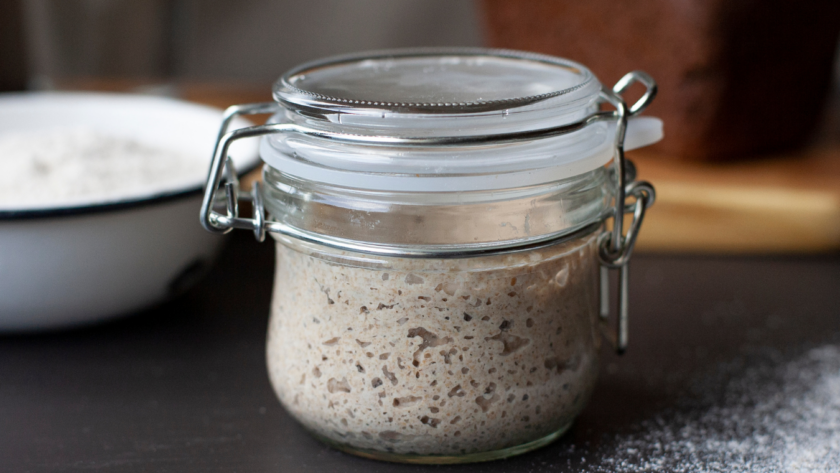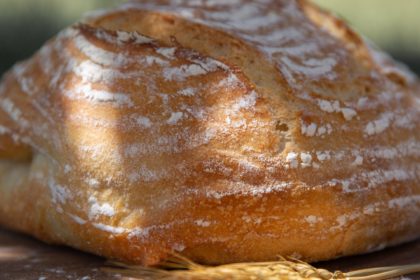Disclaimer: I use affiliate links; if you make a purchase through them, I may receive a small commission at no cost to you.
It took me a while to lean into sourdough baking. I had all the same hesitations I hear from others: I don’t want to be that committed… I don’t want to take care of something every day… sourdough seems hard… Sound familiar?
When you’re just starting out, sourdough can feel like learning a whole new language. But don’t worry—I’ve got you. If I can figure it out, you absolutely can too. Here’s what you need to know to get started (or just to understand what all the fuss is about).
Why Sourdough? The Magic Behind the Craze
Sourdough is different from most breads because it doesn’t use commercial yeast. Instead, it relies on a natural fermentation process using a “starter”—a simple mix of flour and water that captures wild yeast and bacteria from the environment.
The result? That signature tangy flavor, chewy texture, and crispy crust we all love. But it’s not just about taste—many people find sourdough easier to digest, and it has a lower glycemic index than traditional bread. Some folks who are gluten-sensitive even find they can tolerate sourdough (though always check with your doctor if you’re unsure).
In a world full of over-processed foods, I love that I can make something so nourishing with just three ingredients: flour, water, and salt. Once you get the hang of it, I promise you’ll be proud to be part of the sourdough club too.
Common Terms to Know
Before you dive in, here are a few key terms that will help you feel more confident:
Sourdough Starter: A living mix of flour, water, wild yeast, and bacteria that naturally leavens bread. You can make one from scratch, buy one, or (my favorite) get one from a friend.
Sourdough Discard: The portion of starter you remove before feeding. Don’t toss it—there are tons of delicious recipes that use discard!
Feeding: Giving your starter fresh flour and water to keep it active and happy.
Hooch: A liquid that forms on top of your starter if it hasn’t been fed in a while. It’s harmless- just stir it in or pour it off and feed as usual.
Your Starter: The Heart of Sourdough
Your starter is your bread’s best friend. I got mine from another mom and have since shared it with friends—and even strangers on social media. That’s part of the joy of sourdough: it’s meant to be shared.
To keep your starter thriving, all you need is flour and water. I use unbleached all-purpose flour. You’ll also need a kitchen scale (trust me, it makes everything easier).
Here’s how I keep mine in “maintenance mode”:
- Keep 25g of starter in a clean jar
- Feed it with 25g of flour and 25g of water
- Mix, cover, and you’re done for the day!
By the end of the week, I’ve got enough discard to make my favorite weekend pancakes.
When I’m planning to bake, I just scale up the amount of starter I keep and feed accordingly.
A Little Secret: You Don’t Have to Feed It Every Day
If you’re going on vacation, or just need a break, refrigerate it. This slows down fermentation and gives you some breathing room. When you’re ready to bake again, take it out, feed it, and you’re back in business.
HOT TIP: If you don’t want to take care of your starter every day, put it in the fridge.
Quick guide:
- On the counter: Feed every 12–24 hours
- In the fridge: Feed once a week
How Do You Know Your Starter is Ready?
Your starter is ready to bake with when:
- It doubles in size after feeding
- It’s bubbly throughout
- It smells pleasantly tangy
- It passes the “float test” (a spoonful floats in water)
Once your starter passes the float test, it is time to bake your bread! When you get to this step, you will also need a few more kitchen essentials.
If you see a little hooch on top, no worries. Just feed it. But if you see mold or it smells really off, it’s time to toss it and start fresh. (And if that happens—send me a note. I’ll help you get back on track.)
Ready to Level Up?
Once you’ve got the basics down, the fun really begins. You can experiment with:
- Different flours
- Hydration levels
- Baking methods
- And of course, all the discard recipes!
Getting the hang of your starter is just the beginning. I’m right here with you – learning, experimenting, and yes, sometimes failing – so you can rise, bake, and shine.
My Go-To Sourdough Resources
The Perfect Loaf: If you are looking for the Holy Grail around sourdough, this is it. I bought the cookbook and it will take you through the bread-baking process step by step, and provide valuable insight into baking with different hydration levels and grains. This is where I go to troubleshoot because of the thorough explanations.
Farmhouse on Boone: This is the first place I went to learn about sourdough. I use many of Lisa’s recipes, including the sourdough loaf I most commonly bake. There are many awesome discard recipes as well!
Clever Carrot: This is the other place I commonly go for recipes and advice. I have gifted her cookbook to several friends and family (and aspiring sourdough parents)!
I am always looking for new recipes and ways to perfect my technique, so please share your favorites with me!





